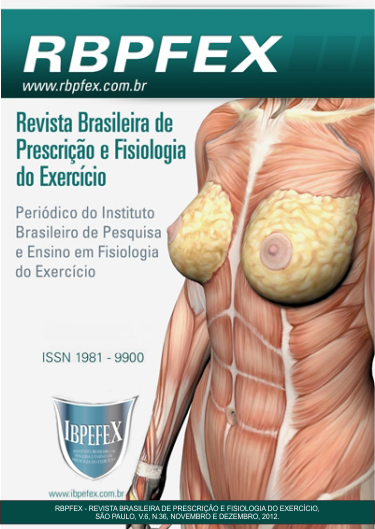Analysis of 1 RM differences on paralell and full squat movements on the smith machine
Abstract
One repetition maximum (1RM) testing has been used as an indirect form of evaluating muscle strength and quantifying training intensity, however, one must know the fator that may influence the results. The purpose of the study wasto compare 1RM values for parallel squat (PS) and complete squat (CS) on a Smith machine. 16 healthy and physically active male subjects (age 25,2 ± 5,8 years, body mass 83,7 ± 8,4 kg). The 1RM tests were performed for each exercise on two separate ocasions randomly and 48-hour appart. Tests consisted of a warm up of 10 repetitions without additional weight to the machine, followed by 3 to 5 attempts with a 3-minute rest interval to find 1RM. Data analysis was made with Shapiro-Wilk normality test and Sudent’s t test for paired samples. Significance level was set at p‹0,05. Results are expressed as means ± SD. 1RM values for PS and CS were 103,8 ± 25,4 kg e 73,3 ± 19,8 kg, respectivelly (p‹0,01), with a percent reduction of 28,7 ± 10,1%. These results allowus to conclude that there is a significant difference between PS and CS, therefore 1RM test must be performed on the specif range of motion applied during training.
References
-American College Of Sports Medicine. Progression Models in Resistance Training for Healthy Adults. Medicine& Science In Sports & Exercise. 2009.
-Bird, S. P.; Tarpenning, K. M.; Marino, F. E. Designing Resistance Training Programmes to Enhance Muscular Fitness A Review of the Acute Programme Variables. Sports Med. Vol. 35. Núm. 10. p. 841-851. 2005.
-Caresitano, A.; Moss, R. F.; Pellinger, T. K.; Woodruff, K.; Lewis, V. C.; Booth, W.; Khadra, T. The effect of back squat depth on the EMG activity of 4 superficial hip and thogh muscles. Journal of Strength and Conditioning Research. Vol. 16. Núm. 3. p. 428-432. 2002.
-Drinkwater, E.J.; Moore, N. R.; Bird, S. P. Effects of changing from full range of Motion to partial range of motion on squat kinetics. J.Strength Cond. Res. Vol. 26. Núm. 4. p. 890-896. 2012.
-Folland, J. P. E.; Williams, A.G. the adaptations to strength training morphological and neurological contributions to increased strength. Sports Med. Vol. 37. Núm. 2. p. 145-168. 2007.
-Granzier, H.L. Activation and stretch-induced passive force enhancement-are you pulling my chain? Focus on “Regulation of muscle force in the absence of actin-myosin-based cross-bridge interaction” Am J Physiol Cell Physiol. Vol. 299. p. C11-C13. 2010.
-Maior, A. S.; Marmelo, S.; Marques-Neto, S. Perfil do EMG em relação a duas angulações distintas durante a contracção voluntária isométrica máxima no exercício de agachamento. Motricidade. Vol. 7. Núm. 2. p. 77-84. 2011.
-Moura, J.A.R.; Borher, T.; Prestes, M. T.; Zinn, J. L. Influência de diferentes ângulos articulares obtidos na posição inicial do exercício pressão de pernas e final do exercício puxada frontal sobre os valores de 1RM. Rev. Bras. Med. Esporte. Vol. 10. Núm. 4. 2004.
-Pereira, M.I.R.; Gomes, P.S.C. Testes de força e resistência muscular: confiabilidade e predição de uma repetição máxima -Revisão e novas evidências. Rev Bras Med Esporte. Vol. 9. Núm. 5. 2003.
-Ronei, P.S; Gomes, N. Radaelli, R.; Botton, C. E.; Brown, L. E.; Bottaro, M. Effect of range of motion on muscle strength and thickness. J. Strength Cond. Res. Vol. 26. Núm. 8. p. 2140-2145. 2012.
-Simão, R. F.; Cáceres, M. S.; Burger, F.; Kovalczyk, L. Lemos, A. Teste de 1RM e prescrição de exercícios resistidos. Revista eletrônica da escola de educação física e desportos -UFRJ. Vol. 2. Núm. 2. 2006.
-Spineti, J.; Salles,B. F.; Rhea, M. R.; Layigne, D; Matta, T; Miranda, F; Fernandes, L.; Simão, R. Influence of exercise order on maximum strength and muscle volume in nonlinear periodized resistance training. J. Strength Cond. Res. Vol. 24. Núm. 11. p. 2962–2969. 2010.
-Tan, B. Manipulating resistance training program variables to optimize maximum strength in men: A review. J. Strength Cond. Res. Vol. 13. Núm. 3. p. 289-304. 1999.
-Wernbom, M.; Augustsson, J.; Thomeé, R. The Influence of frequency, intensity, Volume and Mode of Strength Training on Whole Muscle Cross-Sectional Area in Humans. Sports Med. Vol. 37. Núm. 3. p. 225-264. 2007.
Authors who publish in this journal agree to the following terms:
- Authors retain the copyright and grant the journal the right of first publication, with work simultaneously licensed under the Creative Commons Attribution License BY-NC which allows the sharing of the work with acknowledgment of the authorship of the work and initial publication in this journal.
- Authors are authorized to enter into additional contracts separately for non-exclusive distribution of the version of the work published in this journal (eg, publishing in institutional repository or book chapter), with acknowledgment of authorship and initial publication in this journal.
- Authors are allowed and encouraged to post and distribute their work online (eg, in institutional repositories or on their personal page) at any point before or during the editorial process, as this can bring about productive change as well as increase impact and impact. citation of published work (See The Effect of Free Access).






